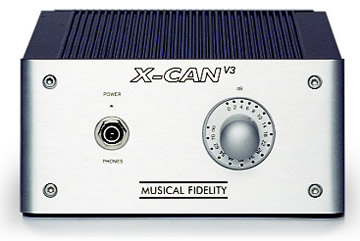
A/B Comparison #7
-
Sigma 22 power supply.
-
Three-channel "Active Ground" topology.
.
-
XCAN is modified per http://www.rock-grotto.co.uk/x-can-v3-tweaks.htm
-
XCAN V3 is a hybrid design with a tube stage and solid state output stage
NOTE: The Musical Fidelity XCAN V3 is a hybrid design, having both tubes and transistors in the signal path. The tube runs at a very low B+ of 60 volts, so it is probably NOT the output stage, but a voltage gain stage. The output stage appears to be a pair of transistors which appear to be bolted together to couple them thermally. Look at the photo, they are near the output coupling caps. The modifications I performed are those widely circulated on the Web: replace all the electrolytics in the power supply with lower ESR / higher temp rated Panasonic caps, replace the power supply diodes with faster / quieter Schottky types, remove the input DC blocking electrolytic cap altogether and switch out the 470 uF output coupling polar electrolytics with 1000 uF nonpolar types. (The stock caps were already bypassed with film types, I left those film bypass caps alone.)
I did some before and after measurements of this amp RE: these mods. After making the modifications there was about 2 dB lower noise and response at 10 Hz with a 200 ohm load came up about 1 dB, to 0 dB (flat, instead of a slight roll-off at 10 Hz.)
LCD-2
XCAN drove the 50-ohm LCD with power to spare, although I did have to dial up the gain just a little when chainging over to the LCD-2's from the HD800s so I could tell the amp felt the impedance change. In some ways the more "intimate" highs of the XCAN were even more noticeable on the LCD-2, which I thought interesting since the LCD-2's doesn't have the slight treble exaggeration of the HD800's that tend to make changes in highs MORE apparent on the Sennheisers than the LCD-2's, generally speaking. Well, not THIS time- here, I could hear the difference in the highs a little more clearly on the LCD-2's. Bass was, again, slightly deeper from the Beta-22.
HD-800
I had some problems get a matching level between the Beta 22 and the XCAN. When I set the levels using a 1000 Hz tone and a voltmeter, the XCAN sounded a little quieter than the Beta-22. I determined that the XCAN has a slightly higher level in the midrange than the Beta-22, I didn't take the time to do frequency sweeps but when I set the levels using a 100 Hz tone and a voltmeter, the two volumes now seemed about equal, with the XCAN having just a slightly richer midrange. So it seems there is a little midrange emphasis from the XCAN. The XCAN also had somewhat different sounding highs. This is hard to describe, but I think it was related to the slightly different harmonic profile of the tube stage adding a slight- very slight- amount of euphonious coloration. Also, the highs didn't sound quite as open or detailed with the XCAN. They didn't sound rolled off, though. Like I said, the highs are kind of hard to describe, but they were slightly different than the Beta-22. Bass from the Beta-22 had a tiny bit more weight than the XCAN. Also, I noticed the XCAN had slightly less channel separation than the Beta-22, and this lead to the sense of space from the XCAN being just a little smaller. Overall, the slightly lower separation, slight midrange emphasis and slightly "sweetened" highs added a feeling of "intimacy" or "closeness to the musicians" that was an interesting voicing, and one which was kind of nice on the HD800s which sounded a little more "clinical" on the Beta-22.
MY CONCLUSIONS
The XCAN sounded pretty good, really, in particular it kind of focussed the listener away from the somewhat emphasized highs of the HD800 without actually rolling off the highs a lot and sounding dark. I might even get to like the XCAN more on the HD800's than the Beta-22. On the LCD-2's I preferred the Beta-22 by a small margin.
The XCAN is a fairly attractive unit. (Put a fancy control knob and a thick aluminum front panel on just about anything and I will probably buy it.)
PHOTOS - the case of the XCAN does not open. Rather, the guts can be slid out.

Detail photo showing original polarized electrolytic output caps replaced with larger-value nonpolar caps; you can also see the the output transistors in this shot.
Copyright © 2011